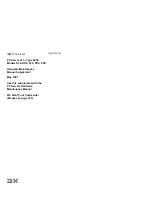
66
AXIS 242S IV - Glossary
type of images (I-VOP's or P-VOP's) included in the
stream, and their internal order. See also
GOV
and
VOP
.
Half-duplex
- See
Full-duplex
.
HTML (Hypertext Markup Language)
- HTML is the set
of "markup" symbols or codes inserted in a file intended
for display in web browser. The markup tells the browser
how to display the page's words and images for the user.
HTTP (Hypertext Transfer Protocol)
- HTTP is the set of
rules for exchanging files (text, graphic images, sound,
video, and other multimedia files) on the web. The HTTP
protocol runs on top of the TCP/IP suite of protocols.
HTTPS (Hypertext Transfer Protocol over SSL)
- HTTPS
is a protocol used by web browsers and servers to encrypt
and decrypt user page requests and the pages returned by
the server. The encrypted exchange of information is
governed by the use of an HTTPS certificate (issued by a
Certificate Authority), which guarantees the authenticity
of the server.
Hub
- A (network) hub is used to connect multiple devices
to the network. The hub transmits all data to all devices
connected to it, whereas a switch will only transmit the
data to the device it is specifically intended for.
IEEE 802.11
- A family of standards for wireless LANs.
The 802.11a standard supports 1 or 2 Mbit/s transmission
on the 5 GHz band. IEEE 802.11b supports data rates up
to11 Mbit/s on the 2.4 GHz band, while 802.11g allows
up to 54 Mbit/s on the 2.4 GHz band.
Image compression
- Image compression minimizes the
file size (in bytes) of an image. Two of the most common
compressed image formats are JPEG and GIF. See also
MPEG
and
Motion JPEG
.
Interlacing
- Interlaced video is video captured at 50
pictures (known as fields) per second, of which every 2
consecutive fields (at half height) are then combined into
1 frame. Interlacing was developed many years ago for
the analog TV world and is still used widely today. It
provides good results when viewing motion in standard
TV pictures, although there is always some degree of
distortion in the image.
To view interlaced video on e.g. a computer monitor, the
video must first be de-interlaced, to produce progressive
video, which consists of complete images, one after the
other, at 25 frames per second. See also
Progressive scan
.
IP (Internet Protocol)
- The Internet Protocol is a method
transmitting data over a network. Data to be sent is
divided into individual and completely independent
"packets." Each computer (or host) on the Internet has at
least one address that uniquely identifies it from all
others, and each data packet contains both the sender's
address and the receiver's address.
The Internet Protocol ensures that the data packets all
arrive at the intended address. As IP is a connectionless
protocol, which means that there is no established
connection between the communication end-points,
packets can be sent via different routes and do not need
to arrive at the destination in the correct order.
Once the data packets have arrived at the correct
destination, another protocol - Transmission Control
Protocol (TCP) - puts them in the right order.
See also
TCP
.
IP address
- An IP address is simply an address on an IP
network used by a computer/device connected to that
network. IP addresses allow all the connected
computers/devices to find each other and to pass data
back and forth.
To avoid conflicts, each IP address on any given network
must be unique. An IP address can be assigned as fixed,
so that it does not change, or it can be assigned
dynamically (and automatically) by DHCP.
An IP address consists of four groups (or quads) of
decimal digits separated by periods, e.g. 130.5.5.25.
Different parts of the address represent different things.
Some part will represent the network number or address,
and some other part will represent the local machine
address. See also
IP (Internet Protocol)
.
Infrared (IR)
- Infrared radiation is radiation at a longer
wavelength than visible light, which means it cannot be
seen by the naked human eye. As infrared radiation can
be detected as heat, this can be shown on a screen or
captured by a digital camera, with hotter objects showing
up brighter against colder surroundings (e.g. a human
body against a colder background).
As color cameras can "see" infrared radiation as well as
visible light, these cameras are equipped with an IR-cut
filter, to prevent distortion of the colors the human eye
can see. To use the camera in very dark locations or at
night, this filter can be removed, to allow infrared
radiation to hit the image sensor and thus produce
images. An infrared lamp can be used for improved
illumination for night surveillance, whilst not producing
any extra visible light.
Inputs/Outputs (I/O's)
- The digital I/Os on, for example,
a network camera can be used to connect any device that
can toggle between an open and a closed circuit.
For example, if a door switch is used as an input device,
opening the door could trigger the upload of video images
and the sending of notification messages.
An output might, for example, be used to automatically
start a siren when there is a motion detection trigger.
ISMA (Internet Streaming Media Alliance)
- ISMA's goal
is: "To accelerate the adoption and deployment of open
standards for streaming rich media content such as video,
audio, and associated data, over Internet protocols."
I-VOP
- See
VOP
.
Содержание 242
Страница 1: ...AXIS 242S IV Video Server User s Manual ...








































